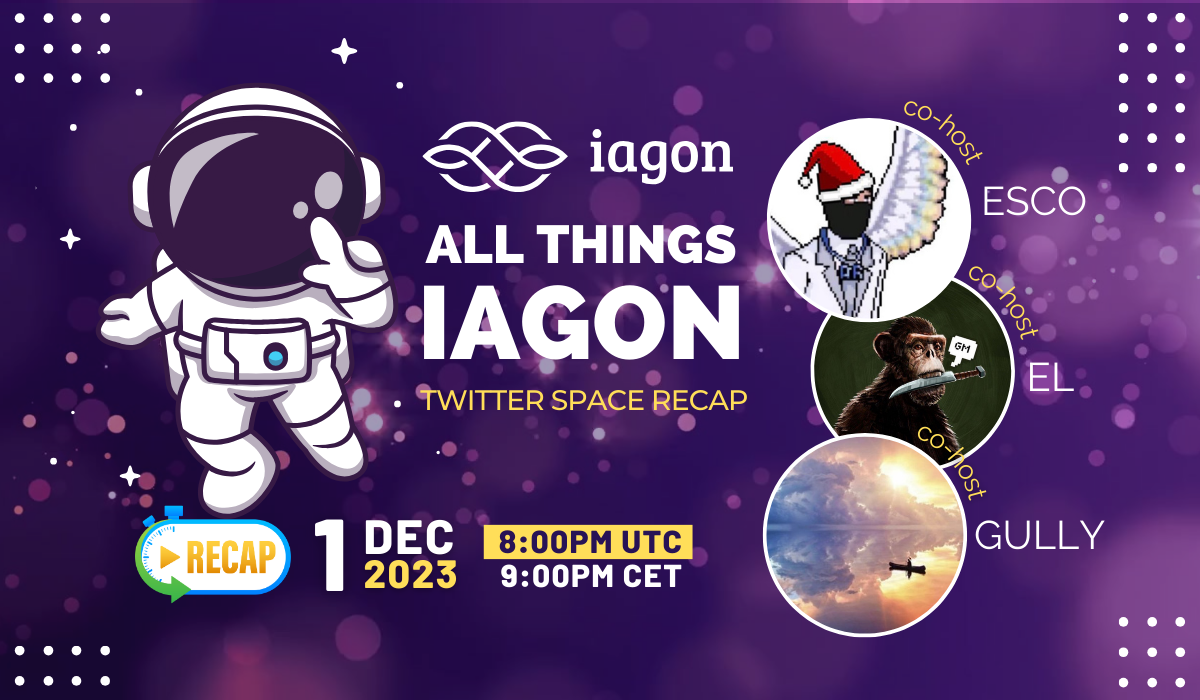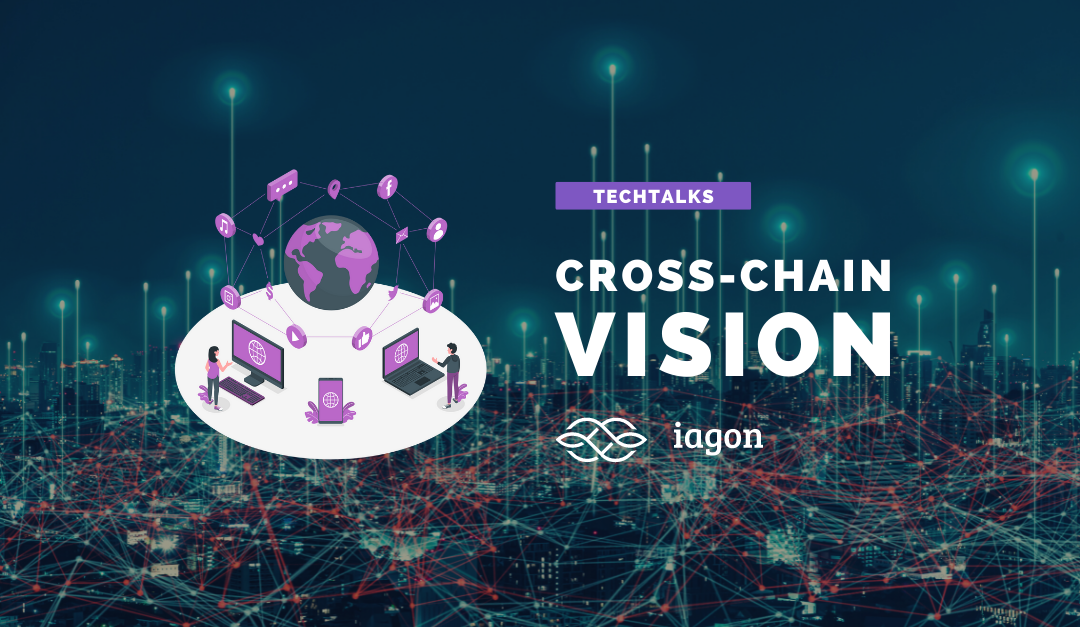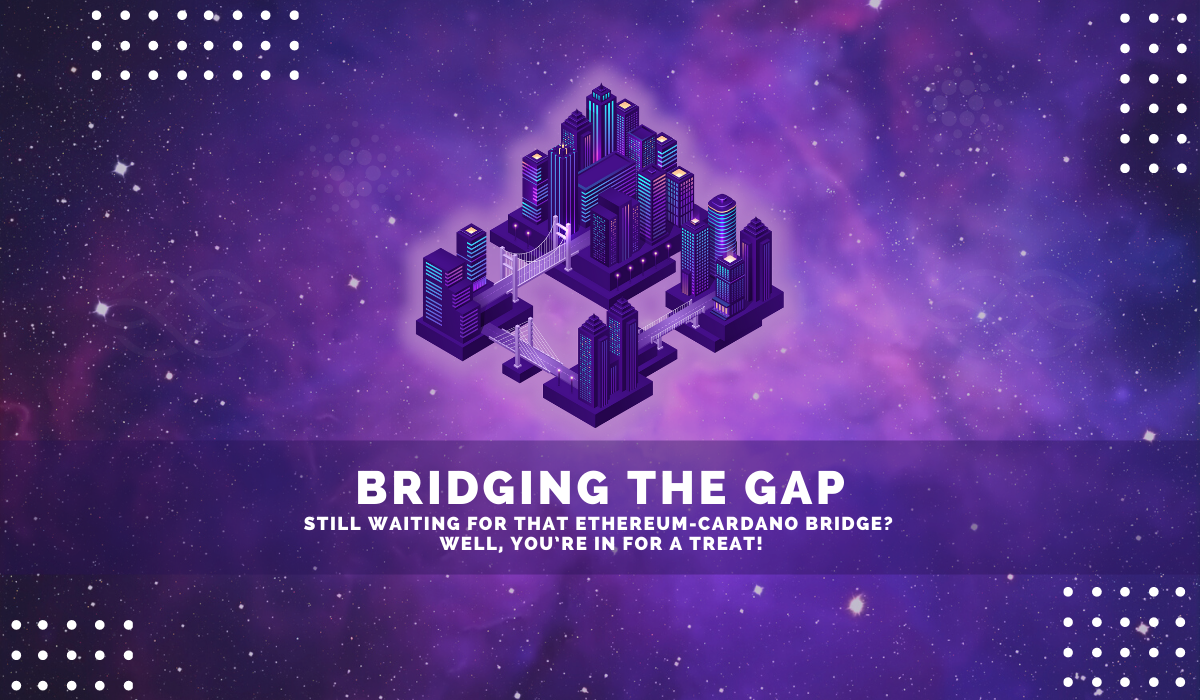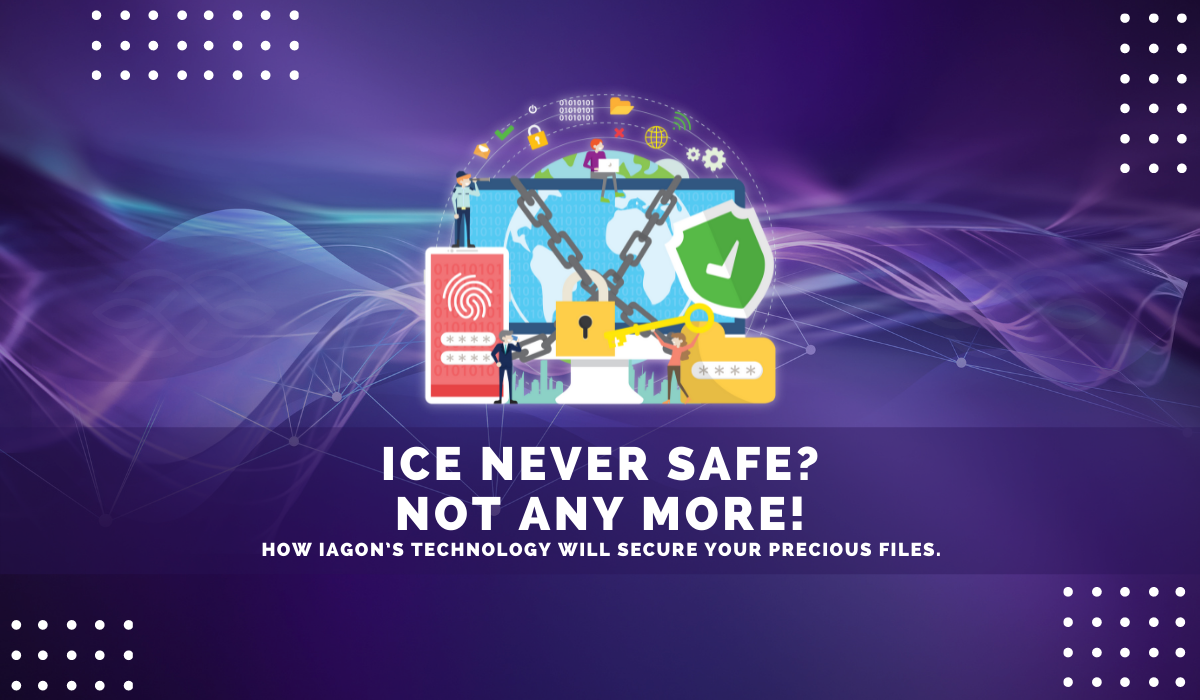This event marked a significant milestone for us, providing an engaging platform to delve into the latest developments within the Iagon universe.
The space proved to be an outstanding opportunity to connect, share, and discuss all things Iagon with our vibrant community. We are deeply appreciative of the enthusiasm and insights shared by each participant, reinforcing the strong bonds within our community.
A special acknowledgment goes to Jackson, a valued member of our community, who diligently compiled a comprehensive recap of the space. His efforts in capturing the essence of the discussion are commendable and we are grateful for his contribution.
For those who missed the live event, we encourage you to immerse yourself in the Iagon universe by listening to the recording of the space or reading Jackson's detailed recap. His work provides an excellent overview of the topics covered and the insights shared during the event.
We are thrilled by the success of our first episode and remain committed to continuing this practice. Stay tuned for more engaging and informative sessions in our 'All Things Iagon' series, as we continue to grow and evolve together with our incredible community.
— Iagon 🧑🚀💽 (@IagonOfficial) December 1, 2023
Dive Deep into the twitter space recap
Date: Dec. 1st, 2023
Hosted by Iagon with our valuable co-hosts: ESCO, EL & Gully
Speakers: Navjit Dhaliwal & Trym Bruset
Navjit Dhaliwal: The journey began in 2013, originating from my experiences in the healthcare sector, particularly in managing patient data and privacy. The initial spark came after reading the Satoshi paper, but due to personal commitments, the project didn't gain significant traction until 2017. The primary motivation was to integrate the security layer of blockchain into healthcare, specifically securing medical files.
In 2017, I decided to focus on the project and sought out a co-founding team to complement expertise. The team was composed of industry experts including Dr. Rohit Gupta, Dr. Elad Harison, and Dr. Claudio Lima, each bringing distinct skills to the table. For instance, Dr. Gupta had early exposure to decentralized computing concepts, dating back to his thesis in 2005.
The project's original focus on securing medical files and ensuring privacy evolved into a broader concept—an intelligent marketplace. This marketplace was designed to match idle storage and compute resources with the needs of end-users. An architectural reconstruction took place between 2017 and 2018, with Ethereum being the chosen platform due to its maturity and robust smart contract capabilities. Although, we ultimately made the decision to eventually bridge to Cardano due to the security and scalability issues associated with Ethereum and that fact that Cardano more appropriately complimented the value proposition of Iagon.
Funding for the project included a 2018 round that raised approximately $550,000, early ICO rounds, and government grants in addition to personal financial commitment until 2021, underlining our vested interest in the project's success. To safeguard the innovative aspects of the project, a decision was made to pursue a patent. In 2018, the relevance of GDPR (General Data Protection Regulation) became apparent, necessitating adjustments in the architecture to comply with data regulations as this will be particularly crucial for onboarding web 2.0 customers.
Why did the project decide to move from Ethereum to Cardano?
Navjit Dhaliwal: The decision to migrate from Ethereum to Cardano in 2021 stemmed from concerns about Ethereum's long-term scalability, transactional fees, and security aspects.
Cardano was seen as a solution, offering advantages such as lower transaction costs, better scalability, and addressing issues like token bridges and smart contract vulnerabilities. The migration to Cardano aligned with the project's goals, especially in terms of offering cost-effective solutions in the marketplace. The decision to switch blockchains was a strategic move driven by a comprehensive evaluation of the project's requirements and the strengths of Cardano as a platform.
What is the Target Market for Iagon?
Navjit Dhaliwal: That's a great question, and we often come across it in the web 3 space. In my previous startup, a dental clinic in Norway, we targeted a niche—emergency care. This strategic focus helped us rapidly build a customer base from 0 to about 2000 patients. We worked overtime, every day, including holidays and weekends, which was appreciated by our patients. It's crucial to identify a niche that allows for quick expansion and aligns with customer needs.
For Iagon, our main focus is on web 2 customers, but we're not closing doors to others. In the transition to web 3, many in the web 2 community haven't fully embraced it. Storage and compute, as infrastructure layers, are vital for businesses, especially in sectors like healthcare that heavily rely on data. We have a broad target market within web 2 that we can tap into. We're open to anyone interested, and we've already had four large enterprises reaching out to us. Our unique features, including security, privacy, and one-click compliance, make us appealing to businesses, and that's reflected in the organic interest we've received.
In essence, we're focusing on web 2 but welcoming anyone who sees value in what we offer. The goal is to be practical and emphasize the tangible benefits that Iagon brings to the table.
Can you explain in simple terms how the sharding works?
Navjit Dhaliwal: Centralized solutions like Google or AWS have a single server holding a specific set of files at a given time. If that server is compromised, all the data is exposed, like a data lake surrounded by a fence—easy access once breached. Privacy is also a concern, as these companies can access and potentially sell your files.
Decentralized storage, as seen with Filecoin, addresses this by sharding data. Sharding involves slicing a file into pieces and distributing them randomly to nodes, which can be any device offering idle storage. This creates a security layer; compromising one node doesn't jeopardize the entire file. However, pure randomness isn't always practical. Iagon adds intelligence by considering node behaviour—performance, availability, location, reputation, and trustworthiness—and matches it with user needs. This way, users can tailor their storage requirements, ensuring high performance, availability, and compliance with regulations, especially on-premises.
Trym Bruset: The sharding mechanism in decentralized storage is crucial. Comparing it to existing solutions like IPFS, where shards are akin to NFTs arranged in a linked list, Iagon introduces a significant innovation. Unlike IPFS, Iagon's sharding algorithm treats each shard as fungible, eliminating the need for a specific order. Loss of a shard doesn't pose a challenge; a threshold collection suffices for file recovery.
This innovation differs from IPFS, which relies on redundancy by creating multiple file instances. Iagon's approach is more scalable, allowing continuous scaling based on desired redundancy. With Iagon, you can specify the exact redundancy percentage without the need for critical nodes. This approach ensures file reconstruction even if nodes go down, enhancing security.
In a simulated test storing a file on 35 nodes, intentionally making 17 nodes go down simultaneously, the file was reconstructed seamlessly. The algorithm's technical security strength lies in its ability to adapt to various parameters and still ensure file integrity. Moreover, the distribution of shards can adhere to specific regions or compliance requirements, offering a compliance-by-default feature.
Can you discuss data sharing and how a user may be able to monetize their own data?
Navjit Dhaliwal: Yeah, and this is an exciting aspect we're actively developing on the Midnight Devnet. Our MVP enables users to share sensitive data selectively, ensuring privacy. For instance, a pharmaceutical company seeking specific information from a demographic can request it from users willing to share. Importantly, users retain full control over their data and can choose whether to participate. Any benefits or compensation offered by the company [asking for the data] can then be shared among the participating users. This innovative approach aligns with our commitment to empowering users with control over their data. The development team is making rapid progress, aiming to be the first MVP on Midnight.
Can you give us some insight into the tools that Iagon is building for regular everyday users as well as commercial and industry users?
Navjit Dhaliwal: For sure, we're not just about storage and compute; we're crafting tools that resonate with everyday and business users alike. One upcoming release is Ledgerflow, a web 3 accounting tool. It simplifies transaction tracking, offering easy multi-signature creation, transaction management, and handling invoices. It's tailored for web 3 businesses but accessible to everyone. Soon, we'll introduce features like recurring payments. Another tool is our decentralized web hosting service, catering to the needs of various web 3 projects.
We're committed to addressing daily challenges. Ledgerflow, for instance, streamlines the complexities of blockchain accounting for traditional accountants. As we face intricate token transactions, particularly in stablecoins, Ledgerflow eases the process and enhances transparency. Forthcoming tools include Statur, a reputation protocol, and multimedia dApps such as encrypted messaging and mail. The storage protocol, a core offering, remains robust, delivering Dropbox-like solutions for enterprises and end-users. Additionally, a WeTransfer-like feature is on the horizon, enabling public file sharing. This holistic approach aims to seamlessly integrate Iagon into users' daily and business activities.
How will Iagon’s solutions be leveraged by users and other projects building on Cardano?
Navjit Dhaliwal: We're working towards providing simple plugins for various functionalities, especially on the compute side. Once the compute side is operational, users will be able to easily integrate different tools within the ecosystem. Whether it's running a Cardano node or executing batch processes for projects like SundaeSwap, our goal is to streamline these processes for end-users.
We're actively exploring partnerships for NFT-related services, like hosting and indexing data. While we can't disclose details yet, discussions with potential partners are ongoing, and we plan to share more insights next week after these discussions progress. The aim is to make NFT-related activities seamless and accessible within the Iagon ecosystem. Stay tuned for exciting updates.
How do you see the recent advancements in AI playing into Iagon and supercharging its use case?
Navjit Dhaliwal: While we haven't had specific inquiries about AI integration yet, the predominant discussions revolve around compliance and privacy, particularly with European entities. The majority of our conversations stem from businesses in Europe, with a few in North America expressing concerns related to international operations, data transfers, and compliance.
However, we completely acknowledge the evolving landscape of technology, especially AI, and anticipate that businesses will increasingly consider these aspects in the near future. The infrastructure we're building at Iagon is designed to cater to the concerns and requirements that arise with the integration of AI technologies. As the technology landscape continues to evolve, we're well-positioned to adapt and provide solutions that align with these advancements.
What are the user acquisition strategies for Iagon?
Navjit Dhaliwal: Our approach to user acquisition and marketing centers around building a strong community through organic growth. The ambassador program is a key component, emphasizing community involvement in Iagon's success. Leveraging the diverse networks within our community, we aim to foster a circular economy where the network's prosperity benefits everyone involved.
The ambassador program incentivizes community members through success fees, encouraging them to onboard clients and contribute to Iagon's growth. We draw inspiration from successful models in the traditional business world that operate on similar success fee structures.
Additionally, we plan to incorporate a creative twist inspired by successful referral strategies, taking cues from the effective approach used by Dropbox. While specific details will be revealed in due course, this strategy aims to further enhance our community-driven organic outreach. Our focus remains on building sustainable growth and fostering active participation from those already engaged with our infrastructure
Is it possible for a use to pull /scrub their data from the network at will?
Navjit Dhaliwal: We recognize the importance of data regulations and compliance. In line with this, our storage network accommodates both mutable and immutable data options. This flexibility ensures that clients can adhere to data regulations globally, including the crucial aspect of data deletion. The ability to scrub or pull data is a key feature, addressing legal requirements and making our solution compliant with data protection laws. This distinguishes our approach from solutions like IPFS, making our platform suitable for adoption by web 2 entities that prioritize regulatory compliance.
Is it possible to retrieve data without a key, what is the likelihood of your data being vulnerable?
Navjit Dhaliwal: Our data retrieval system ensures robust security. Once data is uploaded, only the individual or entity that initially uploaded the data possesses the capability to retrieve it. This ensures a highly secure environment. Even in the scenario of a compromised node, obtaining access to individual shards would be futile as they are essentially meaningless pieces without the complete set. The data remains securely encrypted until the user who uploaded it initiates the retrieval process, enhancing the overall security of the stored information.
What would happen if the network were to ever fork, how would this affect the protocol?
Trym Bruset: In the event of a network fork, the protocol remains unaffected due to its design. The blockchain layer primarily serves as the access layer, storing the hash of the fingerprint of the file on-chain. The forking of the network doesn't impact this aspect since the blockchain's role is centered around managing access. In such scenarios, the protocol adapts by following the correct chain for ongoing access monitoring. It's important to note that the IAGON network itself doesn't maintain a blockchain, making network forks a non-issue for the protocol.
Can you share a bit about the fundamentals of the Tokenomics?
Navjit Dhaliwal: Iagon's tokenomics underwent adjustments during the transition from Ethereum to Cardano. Notably, the team token allocation was reduced following an exploit associated with the transition. The updated tokenomics model emphasizes a circular economy, fostering a mutually beneficial relationship between node operators and users.
Key Aspects of Iagon's Tokenomics:
Circular Economy Model: Iagon's tokenomics revolves around a circular economy. Node operators are required to stake IAG tokens, creating a trust bond, and users pay subscription fees, which are converted into ADA.
Yield on Idle Fees: Fees are paid upfront by users but are paid out to resource providers on a monthly basis to ensure they continue to provide their resources. Fees that have yet to be paid out to resource providers remain active, earning rewards continuously. This involves activities such as ADA delegation or liquidity provision, ensuring ongoing benefits for all stakeholders (Token holders and Resource providers).
Fee Distribution: Node operators receive 90% of subscription fees and any additional fees collected. The remaining 10% contributes to the overall health and growth of the ecosystem, including the Iagon treasury, buyback of IAG tokens, and rewards for IAG stakers.
Staking Mechanisms: Node operators stake IAG tokens, and users can delegate their IAG to node operators to enhance their storage capacity. Liquid staking options will be introduced in subsequent phases.
Iagon's tokenomics aims to create a robust and sustainable ecosystem, with a focus on providing rewards, fostering growth, and ensuring the continuous engagement of network participants.
What is the current state of token vesting for the team tokens?
Navjit Dhaliwal: The team tokens for Iagon have been consistently locked and subject to vesting periods. Initially, the team tokens were locked for 2 years on the Ethereum side, and this has been extended multiple times. As of the latest information, the team tokens are locked for 2 years and then vest over a period of 12 months. The focus of the team is on the project's development and adoption, and there is no rush to unlock or sell team tokens. The vesting and unlocking decisions are made with the intention of ensuring the success and maturity of the project before considering any adjustments to the team token allocation.
As for the development token allocation, is it still being distributed in monthly intervals starting in October, as stated in the documentation?
Navjit Dhaliwal: Yes, it is indeed still being distributed in monthly intervals starting in October.. The monthly expenditure for development is approximately $80,000. The team is mindful of managing the development fund in a way that considers the fluctuation in token prices. The goal is to have a 1-year budget, adjusting the monthly allocation based on the token's value. If the token price rises, fewer tokens are taken out, and if it drops, more may be withdrawn.
The team is also exploring a different approach to the development fund to address community concerns. There is consideration for a treasury sale, where the community would have the opportunity to acquire some of the development tokens instead of the team selling them directly on the market. This approach aims to give the community more control over their investment and mitigate concerns about large token dumps causing market panic. However, it's important to note that nothing has been decided yet, and the team is transparently discussing these options with the community.
What would a treasury sale look like if you did it?
Navjit Dhaliwal: A potential treasury sale for Iagon would involve using the development allocation over a specified period, such as six months, and offering that allocation to the community instead of selling it on the open market. The specifics of the mechanism for this treasury sale, including the platform or portal through which it would be conducted, were not fully detailed at the time we discussed it. We considered the involvement of Drip Dropz for the process but the decision on whether to proceed with a treasury sale had not been finalized. If implemented, the treasury sale would provide the community with the opportunity to participate in acquiring tokens from the development allocation.
Are you still pursuing catalyst for the development of Statur (reputation model) and fluxion (decentralised query tool)? Will they be developed regardless?
Navjit Dhaliwal: To clarify, the team is planning to build Statur (reputation model) regardless, and they are in the process of preparing proposals for Catalyst funding. The proposal for Statur has has been submittet, but we are fine-tuning this before we share publicly.. Statur and Fluxion are both part of the project's roadmap, and the team is committed to their development. The focus will be on the mainnet initially, and then proposals for these components will be finalized and submitted to Catalyst for funding. Statur is expected to be open source, which means the community will be more involved in its development.
When will Iagon launch on Mainnet?
Navjit Dhaliwal: The team is gearing up for the Alpha version release, scheduled for this upcoming Friday (Dec. 8th). This version is essentially very similar to the mainnet version in terms of functionality. The mainnet itself is ready, pending the final audit, and the audit's expected completion is before Christmas, which aligns with the planned launch date. This pending audit report is the last piece before the mainnet goes live. The team is releasing the Alpha version first for users to test on a preview or pre-production network, allowing for feedback and any necessary minor adjustments before the mainnet launch, which is anticipated to follow soon after.
How successful was the Iagon Test-net?
Navjit Dhaliwal: The Iagon Testnet has seen significant interest and engagement, with over 800 nodes participating. Currently, there's over 1 petabyte of data being provided on the Testnet. The team has observed substantial participation and hopes that this enthusiasm will carry over to the Mainnet. If the Mainnet experiences a similar level of engagement, Iagon could instantly become one of the major players in the blockchain storage network space.
How will Iagon disrupt gaming, specifically for browser based games?
Trym Bruset: For gaming applications, Iagon plans to focus more on this aspect when the compute feature is rolled out in Phase 3, which is scheduled for Q1 next year. Gaming will specifically leverage a feature of the Iagon network that we refer to ‘Beehives’ and ‘Bees’. The Beehive concept revolves around addressing challenges related to decentralized systems, particularly in finding and managing files in a decentralized storage network.
In the context of gaming, the Beehive aims to provide solutions for routing and tracking shards, which are the distributed and encrypted shards of files in the Iagon network. The goal is to create a decentralized system where you can efficiently locate and retrieve files for gaming applications. Additionally, the Beehive concept involves a replacement mechanism. If a Hive (responsible for routing shards) or nodes storing gaming-related files go down, the Bee service steps in to identify and reconstruct the lost or corrupted data.
Likewise, if you wanted to release a new update for your game, you could go through a similar process as you traditionally do where you simply replace the old files with the new ones.
How does Iagon rank among other file storage applications like Filecoin?
Navjit Dhaliwal & Trym Bruset : The comparison between Iagon and other file storage applications like Filecoin involves several considerations. While Iagon's solution is not yet live, the focus is on attracting enterprise clients by addressing data regulations and privacy concerns. Iagon aims to provide a compliant and secure storage solution for enterprises, emphasizing factors beyond just pricing.
Filecoin, known for its cost-effectiveness in storage, is recognized as one of the cheaper solutions. However, Iagon stresses that its primary focus is not on being the cheapest but on creating value for users. The team has engaged with enterprises, and their conversations indicate that data regulations, compliance, and security are paramount concerns for potential clients. Pricing becomes a secondary consideration for many enterprise clients, emphasizing the importance of features related to data protection and security.
Moreover, Iagon distinguishes itself by building decentralized applications (DApps) on top of its infrastructure, aiming to offer more value to users. Ledger Flow and other DApps contribute to an ecosystem where users receive additional benefits beyond basic storage services.
Additionally, the structural differences in the underlying technology are highlighted. Filecoin employs a proof-of-storage consensus model, requiring nodes to prove they have an entire dataset which is continuously growing. This approach, while effective for smaller networks, could lead to centralization as the network grows and more and more storage is required to participate. In contrast, Iagon's design allows nodes to provide specific amounts of data without requiring the entire dataset, preventing centralization concerns associated with proof-of-storage mechanisms.
In summary, while both Iagon and Filecoin offer storage solutions, their focus, target audience, and underlying technology differ significantly. The evaluation extends beyond pricing to factors such as data compliance, security, and the creation of additional value through decentralized applications.
Can you share a bit more about how Staking IAG will work?
Navjit Dhaliwal: Staking IAG will involve earning rewards in both IAG tokens and subscription fees. The revenue generated by the company will contribute to the rewards distributed to both those staking IAG and the node operators. Initially, staking will have a set timeframe, but liquid staking is planned for the future. The team is in the process of creating NFT utility contracts, and once completed, liquid staking will be implemented, allowing for increased flexibility in staking IAG tokens.
How will Iagon be able to integrate into systems (like healthcare) that use closed loop to store data and require storage providers to be pre-approved?
Navjit Dhaliwal: Iagon has considered the need for integration into systems, such as healthcare, that operate in closed loops and require pre-approved storage providers. The platform allows for optional information sharing, and node operators can provide details like their location and other variables if they choose to do so. In the context of healthcare, a certified node operator could go through a verification process, obtaining relevant certificates, and making their data center available for approval by healthcare institutions.
This approach allows for a private network within Iagon, where institutions like healthcare or financial entities can pre-approve specific, verified data centers
For more information and other updates, please follow us on our social media , or head over to the IAGON Website!




